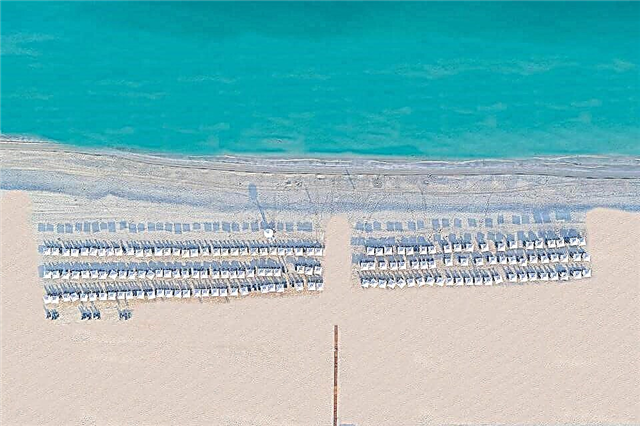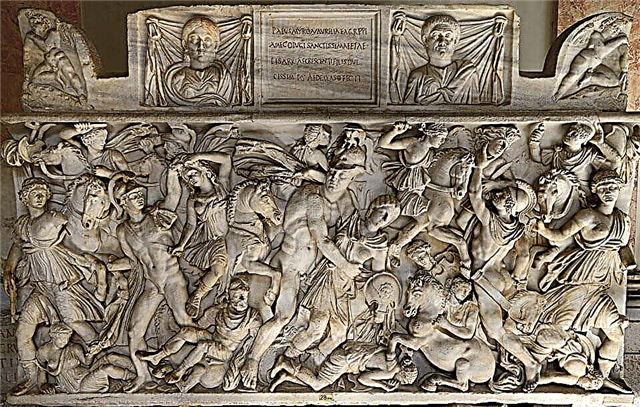The women's monastery near Galich is one of 18 currently existing in the Kostroma region, and one of the oldest. It was founded in the middle of the XIV century. The monastery is located on a hill among the fields, and from it a magnificent view of the city quarters of Galich and the large Galich Lake opens up. Today this monastery has been restored and receives pilgrims and tourists every day.
The history of the founding of the monastery
The ancient city of Galich appeared on the Kostroma lands in 1159. It was founded by Yuri Dolgoruky as a fortified point designed to protect the northeastern borders of the Rostov-Suzdal principality. In the middle of the XIII century, the city and its environs received the status of an independent principality, and the brother of Alexander Nevsky, Konstantin Yaroslavovich, became the first prince of Galich.

The Holy Dormition Paisiev-Galich Monastery from a bird's eye view
Around the middle of the 14th century, a monastery was founded in the south of the city. A wooden church and cells for monks were erected on a high place - Mount Krasnice. These were patrimonial lands that belonged to the boyar John Ovin, who was a devout man and built the monastery at his own expense.
Christian tradition tells about the miraculous appearance of the image of the Mother of God. This event happened on the day of the celebration of the Assumption of the Virgin. When the tutor came to the monastery, he was met by two young men. They gave Ovin the icon of the Mother of God. This iconographic image later received the glory of miraculous. In honor of the acquisition of the icon with the money of the boyar, a wooden church of the Assumption of the Virgin was built in the monastery, the monastery itself was called the Assumption, and the icon - by the name of the boyar "Ovinovskaya". There are disagreements regarding the time of the appearance of the miraculous image. Some believe that this event took place in 1425, while others argue that the icon appeared earlier - in 1383.

General view of the Holy Dormition Paisiev-Galich monastery
After the boyar's death, the monastery was patronized by his son-in-law Ioann Yartsov, who at the end of his life received the monastic tonsure under the name of Jonah. Then his son Dmitry was the tutor of the monastery. And when he fell ill, Dmitry bequeathed all his patrimonial lands to the monastery before his death.
Saint Paisius
The history of the Kostroma monastery is closely connected with the life of the Venerable Paisius of Galich, revered by Christians. It is not known when and where the saint was born and at what age he took monastic vows. There is information that in 1385 he appeared in a monastery near Galich and at first underwent monastic obediences here. Paisiy worked as a baker, chopped wood and cleaned the monastery territory. Over time, for great diligence and humility, he was ordained a hierodeacon, a little later he became a hieromonk, and then hegumen.

Entrance to the Holy Dormition Paisiev-Galich Monastery
At that time, quarrels between the Moscow and Galich princes over the right to own land were commonplace. Often these disputes escalated into conflicts and even armed clashes. Paisius did not interfere in the affairs of secular rulers, believing that all power is from God. However, the abbot made a lot of efforts to reconcile the princes and avoid bloodshed.
With a specially prepared copy of the icon of the Dormition of the Mother of God, Paisy went to Moscow to see Grand Duke Vasily II and Metropolitan Jonah. As a token of gratitude for the icon handed over, Paisius was presented with a letter of protection, in which the governors of the prince in the Galich lands were instructed to protect the monastery in every possible way and contribute to its prosperity. And Paisius himself was elevated to the rank of archimandrite by the Moscow metropolitan.
Paisiy died already at an advanced age - in 1460 and was buried under the southern wall of the Assumption Church. He was canonized as a saint in 1682.

Holy Gates of the Holy Dormition Paisiev-Galich Monastery
The history of the monastery from the 17th to the 20th century
After the death of Paisiy, the monastery was named in his honor - the Assumption Paisieva. In the 17th century, at the expense of funds allocated by Prince A.M. Lvov, who had extensive possessions in the Kostroma lands, began to build stone temples here. In the 1640s, a stone summer Assumption Cathedral appeared in the monastery. And a little later, a two-story three-domed Trinity Church was built for services in the winter months.
Unfortunately, the monastery has lost the miraculous image acquired thanks to the boyar Ovin. Historians believe this could have happened in the Time of Troubles or during fires. Therefore, at the beginning of the 18th century, a new icon was painted, and it took an honorable place in the iconostasis of the main monastery church. In the 18th, 19th and early 20th centuries, this icon served as an object of constant pilgrimage.

From left to right: the Church of the Life-Giving Trinity and the Cathedral of the Assumption of the Blessed Virgin Mary
With the advent of Soviet power, the old Galich monastery remained active. However, in 1919 it was closed. And although the monastic brethren were disbanded, services for parishioners were still held in both churches until the early 1930s. After an active anti-religious campaign began in the country, church services were banned here. The premises of the monastery cathedral were converted into an incubator. And the Trinity Church was made a warehouse for firewood, having previously destroyed all its chapters. The fence around the territory was dismantled into bricks and the old cemetery was destroyed.
In the 1970s, a large fire broke out in the former monastery, which almost destroyed the old churches. At the end of the 20th century, everything was finally abandoned, and both temples were destroyed more and more year after year.

Cathedral of the Assumption of the Blessed Virgin
In early 1994, it was decided to revive the Orthodox women's monastery on the territory. A year later, archaeologists conducted excavations near the ancient temples. Their results surprised everyone. Beneath the cathedral were the remains of the Monk Paisios. When the place of their storage was opened, it turned out that, apart from a small part of the left forearm, there were no more bone remains. But on the ground there was a clear imprint of Paisius's face, as well as his archimandrite rod. The first church service was held here on June 5, 1997 - the day when Christians celebrate the memory of St. Paisius of Galich.
Temples and buildings on the monastery territory
The most ancient structure in the monastery is the picturesque two-pillar cathedral of the Assumption of Our Lady, built between 1642 and 1646. This is a wonderful monument of temple architecture of the 17th century. The central head of the Assumption Cathedral is noticeably larger than the side ones. All five chapters have an expressive helmet-shaped end and are painted in silver. A low hipped bell tower is attached to the three-absided main volume.

Another temple that has survived on the territory of the monastery is the Trotskaya Church. It appeared later than the Assumption Cathedral - in the middle of the 17th century and served as a winter church. The rectangular main volume is stretched from east to west. In the middle of it there is a two-story quadrangle, which was previously crowned with three church heads, placed in one line. This is a rare example of a three-domed temple. The central of the chapters was illuminated. On the sides of the quadrangle there are a rectangular altar room and a square one-pillar refectory. Outside, the Trinity Church is decorated with a profiled cornice and smooth blades at the corners of the building. The architecture of this temple shows that it has been altered many times.
In addition, on the territory of the monastery there are nursing and abbot buildings, a fence with the Holy Gates and buildings for household needs. A hotel has been created for the pilgrims who come here.

Current state and visiting regime
Nowadays, the women's monastery is active, and 9 nuns live here.The monastery buildings are well restored, and the territory is landscaped and open to pilgrims and tourists. Taking pictures inside the monastery is allowed only with the permission of the abbess. The inside of the cathedral is allowed only during the divine services. Since 2004, an old copy of the revered icon of the Assumption of the Mother of God, which was previously located in Galich, has been kept here. Every year, on the day of Paisiy Galichsky, a large procession is traditionally held.
How to get to the monastery
The monastery stands on the southern outskirts of the ancient city of Galich, in the village of Uspenskaya Sloboda, at the address - st. Uspenskaya, 11. This place is located 1.3 km south of the Galich railway station.

An intercity bus runs from the bus station in Kostroma or the Galich bus station to the monastery. You need to go to the stop "Uspenskaya Sloboda".
If you get by car, then from Kostroma you need to go through Sudislavl. Then, before reaching Galich, turn left from the P100 highway - to Fominskoye. From the turn to the monastery - 1.5 km.
A taxi ride from the center of Galich to the monastery takes 15-20 minutes. In addition, the monastery can be reached on foot from the Galich railway station in half an hour.
Attraction rating:











